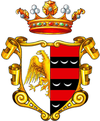Ceccano
| Ceccano | ||
|---|---|---|
| Comune | ||
| Comune di Ceccano | ||
 |
||
|
||
| Location of Ceccano in Italy | ||
| Coordinates: 41°34′N 13°20′E / 41.567°N 13.333°E | ||
| Country | Italy | |
| Region | Lazio | |
| Province / Metropolitan city | Frosinone (FR) | |
| Government | ||
| • Mayor | Roberto Caligiore | |
| Area | ||
| • Total | 60 km2 (20 sq mi) | |
| Elevation | 200 m (700 ft) | |
| Population (30 June 2011) | ||
| • Total | 23,504 | |
| • Density | 390/km2 (1,000/sq mi) | |
| Demonym(s) | Ceccanesi | |
| Time zone | CET (UTC+1) | |
| • Summer (DST) | CEST (UTC+2) | |
| Postal code | 03023 | |
| Dialing code | 0775 | |
| Patron saint | St. John the Baptist | |
| Saint day | 24 June | |
| Website | Official website | |
Ceccano is a town and comune in the province of Frosinone, Lazio, central Italy.
The town had its origins as an ancient Volscian citadel that surrendered to the Romans in 424 BC. Its name in ancient times was Fabrateria Vetus.
According to tradition, the name was changed into the current one in the early Middle Ages, in honor of one Petronius Ceccanus, father of Pope Honorius I. Conquered by the Lombards at the time of King Aistulf (c. 750), later it became an important fortress of the Papal territories. In 1218, a monk from nearby Fossanova Abbey compiled the Annals of Ceccano. From 900 to 1450 it was ruled by the local Counts of Ceccano, most likely of German origin; later their territories were assigned to Rodrigo Borgia by Pope Alexander VI and then to the Colonna family.
From 3 November 1943 and 31 May 1944, during World War II, the town suffered 38 air attacks from Allied forces despite having no strategical importance; in one of them the Church of Santa Maria a Fiume, a national monument, was destroyed. Canadian Army war artist Charles Comfort painted the town as it appeared during the Second World War.
During excavations for the construction of the TAV high speed railroad, remains of a large Roman villa have been discovered.
...
Wikipedia


